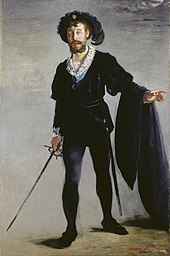Ambroise Thomas
During his time there he became friendly with the painter Ingres, the head of the academy, with whom he shared an admiration for both Mozart and Beethoven; he also met Berlioz, who encouraged him and wrote about him favourably.
His first completely successful three-act opera was Le caïd (The Qaid, 1849), described by the musicologist Elizabeth Forbes as "a mixture of Il barbiere di Siviglia and L'italiana in Algeri";[4] it remained in the French operatic repertoire throughout the nineteenth century, and achieved more than four hundred performances over the next fifty years.
[4] Forbes writes that, unusually, Thomas had the advantage of a well-judged and theatrically effective libretto, and that although in the novel Mignon dies, the happy ending works well in the opera.
)[4] The strong original cast featured, in the title role, Célestine Galli-Marié, a celebrated singer who later created the part of Carmen in Bizet's opera.
Although the adaptation was seen as a travesty of the play, with a ballet-divertissement (obligatory at the Opéra) and a happy ending, with Hamlet acclaimed as king, the work was successful not only in Paris but in London.
[13] Despite disparaging reviews of the libretto from English-speaking critics at the time and subsequently,[n 4] the work has remained an occasional part of the operatic repertoire; later singers of Ophelia included Emma Calvé, Emma Albani, Nellie Melba and Mary Garden, and among the Hamlets have been Victor Maurel, Titta Ruffo, Mattia Battistini and more recently Sherrill Milnes, Thomas Allen and Thomas Hampson.
[24] Thomas was, on the other hand, innovative in the running of the Conservatoire: he increased the number of classes, improved the conditions of the faculty, and expanded the curriculum to include solfège, sight-reading and compulsory orchestral practice.
[25] The faculty under Thomas included, at various times the composers Franck, Théodore Dubois, Jules Massenet and Ernest Guiraud, and the singers Pauline Viardot and Romain Bussine.
[3] In 1894, after the 1,000th performance of Mignon at the Opéra-Comique, the octogenarian composer was embraced on the stage by Verdi, his junior by two years, before President Carnot decorated Thomas with the ribbon of the Grand-Croix de la Légion d'honneur.
[31] A contemporary assessment was given in the first edition of Grove's Dictionary of Music and Musicians (1889), where Gustave Chouquet wrote of Thomas: He brings to his task an inborn instinct for the stage, and a remarkable gift of interpreting dramatic situations of the most varied and opposite kinds.
His skill in handling the orchestra is consummate, both in grouping instruments of different timbre, and obtaining new effects of sound; but though carrying orchestral colouring to the utmost pitch of perfection, he never allows it to overpower the voices.
[32]In the 2001 edition of Grove, Langham Smith writes, "In the context of French opera of the late 19th century Thomas was a figure of considerable importance, an imaginative innovator and a master of musical characterization.
"[3] Langham Smith concludes that after years of neglect, Thomas' work saw a considerable revival, beginning in the late 20th century, with major productions of Mignon and Hamlet in France, Britain and the US.
In later works, Thomas' music could still be derivative: Forbes cites Psyché (1857) as "an inferior copy of Gounod's Sapho" and his Le carnaval de Venise (also 1857) as imitating Victor Massé.






